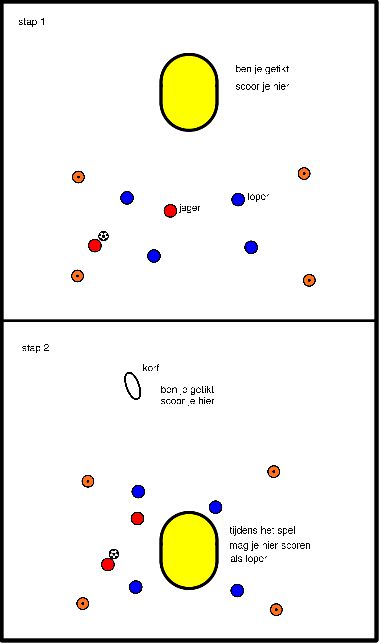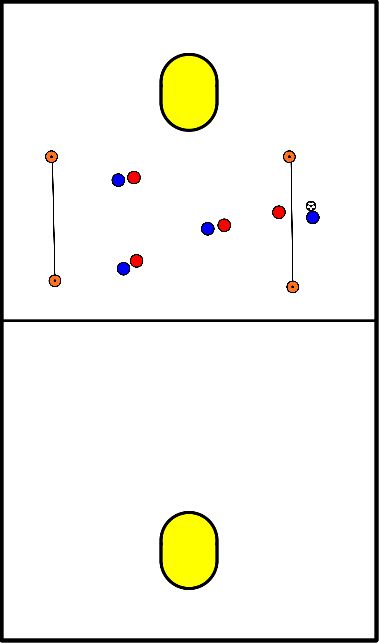Korfball exercises for u6
Step 1:
- As a hunter duo, try to move yourself around the field, playing over and throwing off as many runners as possible within 1 minute.
Step 2:
- Try to take the ball away from the hunters as quickly as possible, play over and score in the basket, but be careful not to get tapped by the hunters.
- This is allowed when you have the ball in your hands.
Rules:
- Lay the hats down in a square with approx 5m between the hats.
- Two players are the tappers, the rest move inside the square.
- The two scapegoats are allowed to scapegoat the other players with the ball. The catchers are not allowed to walk with the ball.
- By throwing over the ball the taggers can tap the other players.
- If you are tagged or left outside the box, you are out and you can join again if you have scored a goal.
- At step 1 the runners are not allowed to touch the ball of the hunters.
Variation:
- When players are out, they belong to the tag team instead of being out of the box.
- This is only allowed after they have scored.
- More or less players and therefore more or less balls.

Task:
- Who is the first to circle the ball or the player?
Rules:
- Everyone stands in a circle with enough space to throw a ball quickly.
- The ball starts to the right of the child who is going to run.
- The child who is going to run, runs at the same time as throwing the first ball on the outside of the circle.
- You stand on a large field.
- You make 2 teams 1 team stands left behind the line and the other team right behind the line.
- 1 big ball, lies in the middle of the field.
- Each player has a ball.
- They try to hit the ball from behind the line and roll it over the line of the opponent.
- After throwing you pick up your own ball and stand behind your own line again, and you start aiming at the big ball again, until the ball has crossed someone's line.
- Players run/dribble around a set square. (poles/pawns, sufficient distance from each other).
- Players are given a list of commands in advance, with a corresponding number.
- The trainer calls out a number randomly, players carry out the assignment.
- You can adjust the number of missions and the missions themselves.
- Example of assignments.
- Tapping the ground.
- Jump in the air.
- Sprint to the next pole.
- 1 burpee.
- Backwards as if you are defending until the next pole/pawn.
- Everyone in a circle or whatever.
- Pass the ball around by throwing with two hands.
- Pay special attention to the technique of throwing the ball.
- When this has been done a few times you can switch styles, so for example with one hand.
- Or perhaps above the head.
- Alternate in this.
- On the field, place x number of hats at random spots, half on his point.
- You play with 2 teams of 1 or more players.
- Party A puts the hats on the point party B puts them the other way around.
- After x minutes stop and count who has the most hats.
Objective:
- Earn a point by catching the ball over the line.
Rules:
- A party starts from behind the line with the ball.
- Intercepted ball is ball first to your own line and then to the other side for a point.
- Balls out count.
- When a point is gained, the opponent gets the ball from there.
Points of attention:
- For defending.
- Play on the side by moving on one leg.
- Play at tempo.
- Watch each other and your opponents place.

- Make a circle at the level of your head on the wall (with sidewalk chalk)
- Make the circle about the same size as a basket.
- Now stand 3 or 4 meters away from the circle.
- Now throw the ball with your left against the wall and catch it with your right hand.
- Do this for one minute.
- The ball must not bounce on the ground.
- If it is too easy, stand further away or try to throw the ball faster. If the exercise is too difficult, try to catch the ball with two hands, but still throw with one hand
- Or stand a little closer to the wall. (Outdoors exercise)
In short: practicing various shooting variants in a fun competition form.
- Organization: per group a basket and a ball, the baskets are preferably (but not necessary) arranged in a circle or rectangle.
- The number of persons per group is less important (but all groups are about the same size).
- The first assignment for the groups is: score 10 goals.
- When you have completed this assignment, the person who scored the last goal runs to the trainer to pick up the next assignment.
- Which group completed all assignments first?
- The trainer walks around, encouraging, or correcting.
- He has a piece of paper with him with a row of assignments on it.
- When someone comes to pick up the next assignment, first ask which one has just been done (this can vary considerably over time) and then hand out the next assignment.
- An example list: 10 walk-through balls, 15 penalty shots, 5 8-meter shots, 10 walk-through balls from behind the basket, 5 dodge balls next to the pole, 10 6-meter shots.
- Everything is possible of course, a lot of momentum is gained if the number of goals to be scored is kept small.
- 10 walk-through balls
- 20 small oppertunities
- 6 remote shots
- 10 penalty throws
- 1 backwards
- Practicing throwing and releasing on the short and long line.
- The declarer stands far from the basket. The archer stands in front of the box at the side of the declarer.
- The archer walks up to the declarer (the short line), receives the ball and shoots.
- The declarer becomes a shooter, the shooter walks to behind the basket, the catcher arrives at the position of the declarer, after the ball is thrown to the next declarer.
Variant:
- The shooter chooses the long line after feinting towards the short line or basket.
- Both variations can be trained with the opponent near the shooter, so that the declarer learns to judge when someone is free.
- Dose the defender. When using a defender, the 2nd declarer (who in fact does nothing) can act as a defender.
- The rotation after the exercise is: declarer becomes defender, defender becomes gunner, gunner becomes catcher and catcher becomes declarer (after a combination with a player).
- Practicing throwing and releasing on the short and long line.
- The declarer stands far from the basket. The archer stands in front of the box at the side of the declarer.
- The archer walks up to the declarer (the short line), receives the ball and shoots.
- The declarer becomes a shooter, the shooter walks to behind the basket, the catcher arrives at the position of the declarer, after the ball is thrown to the next declarer.
Variant:
- The shooter chooses the long line after feinting towards the short line or basket.
- Both variations can be trained with the opponent near the shooter, so that the declarer learns to judge when someone is free.
- Dose the defender. When using a defender, the 2nd declarer (who in fact does nothing) can act as a defender.
- The rotation after the exercise is: declarer becomes defender, defender becomes gunner, gunner becomes catcher and catcher becomes declarer (after a combination with a player).
- Two players stand 7 metres in front of the basket and 8 metres apart.
- A player with the ball under the basket and a receiver slightly behind the basket.
- A player in front of the basket takes the through ball indicated from space, after the other player in front of the basket has received the ball.
- The ball is caught by the receiver.
- A1 becomes A2,
- A2 becomes A3,
- A3 becomes A4 and
- A4 becomes A1.
What can you see?
- The handler learns that the shooter can only take a walkthrough ball if the throw is prepared calmly, thrown in front of the shooter and the ball is placed at the right height.
- Walking pace and walking distance of the archer can be controlled by the throwing pace, ball path and ball pace.
- Learning to control problems such as timing requires a lot of repetition and sometimes adjustment of the distances used.
- The problems for the shooter, the starting position of the through ball is different because the body is turned to receive the ball, lead to unclean actions. Stay attentive to this.
- The speed of action should be increased.
Variation:
- As exercise 12, but the declarer throws the ball to a shooter who swings out to a position diagonally behind the basket.
- There is a ball through the middle where the declarer from the space in game situation must take into account two opponents, his direct opponent and the opponent of the shooter, after all he is not far from the ball line.
Variant:
- The shooter makes a feint and plays the ball through to the player under the basket who signals a through ball.








